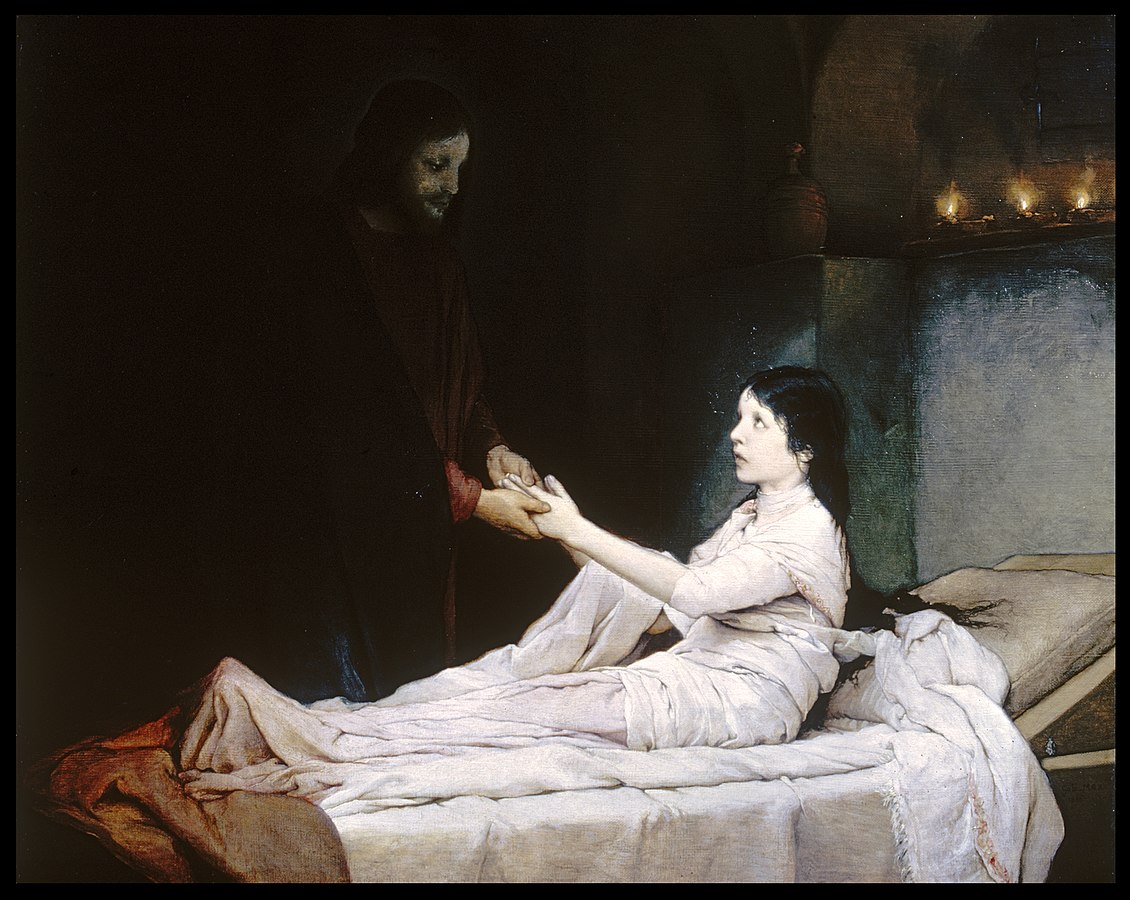
Few experiences in life are more challenging than waiting for relief from suffering, your own, certainly, but especially the suffering of a loved one. Suffering can yield self-revelation. People’s darker or brighter sides come to the surface. Their relationships change. They often open themselves up to God. It is especially in our intersection with God in suffering that deep self-discovery takes place. As the Second Vatican Council’s document Gaudium et spes 22 teaches, Christ came into the world to reveal man more fully to himself. He did this for us, His images, but showing who He is in His earthly ways and words, but in a supreme way in His suffering and death in expiation for our sins.
Our Gospel for this 23 Sunday after Pentecost drills into the intersection of God and suffering and the force-multiplying factors of waiting for and the agony of watching another suffer. This week we hear from Matthew 9 and the healing of Jairus’ daughter as well as the encounter of the Lord with the Haemorrhissa. We can draw more details about this encounter from the parallel passage in Mark 5. Mark doesn’t recount as many of Christ’s miracles as Matthew, but sometimes he provides more details.
The Lord and his Apostles were in Capernaum, a handy place for His ministry since it was on a well-travelled route and tales of what He did and said would be spread quickly. In this chapter, for context, Jesus worked healings and had just called Matthew. The Markan account says the episode of the Gerasene Demoniac had taken place on the other side of the Sea of Galilee and then they crossed over A “ruler” or “archon” approached the Lord, Mark says “archisynagogos” or “a leader of the synagogue”. He begged the Lord to come and lay hands on his 12 year old daughter who was at the point of death. One might imagine the anxiety of the man, Mark names him Jairus, together with the desperate hope he felt as the Lord went with him towards his home. Great crowds are pressing around – “they thronged (synethlibo) Him” making it hard to hurry, which surely increased Jairus’ frantic urging.
 In this struggle to get through the press, the Lord stopped – no doubt to Jairus’ dismay – and said, “Who touched me?”, a strange thing to ask given the crowds. A woman, “fearing and trembling” made herself known saying that she had been healed of a twelve-year long “flow of blood” by simply touching Jesus’ clothes (himation). The account in Luke says, “the border of his garment … kráspedon autou himatíou”. This was probably one of the dangling tassels called tzitzit on the edge of the rectangular prayer shawl or tallit Jewish men wore as reminder of their covenant with God (Num 15:48-40). In Mark and Luke, Christ felt power go out from Him, which is not said in Matthew’s account. In Matthew, Christ said, “Take heart, daughter; your faith has made you well,” and then she was healed. In Luke and Mark she was healed by her touch of Christ’s tzitzit.
In this struggle to get through the press, the Lord stopped – no doubt to Jairus’ dismay – and said, “Who touched me?”, a strange thing to ask given the crowds. A woman, “fearing and trembling” made herself known saying that she had been healed of a twelve-year long “flow of blood” by simply touching Jesus’ clothes (himation). The account in Luke says, “the border of his garment … kráspedon autou himatíou”. This was probably one of the dangling tassels called tzitzit on the edge of the rectangular prayer shawl or tallit Jewish men wore as reminder of their covenant with God (Num 15:48-40). In Mark and Luke, Christ felt power go out from Him, which is not said in Matthew’s account. In Matthew, Christ said, “Take heart, daughter; your faith has made you well,” and then she was healed. In Luke and Mark she was healed by her touch of Christ’s tzitzit.
Because of the Old Testament Law in Leviticus 15 anyone with a “flow” from their bodies, of whatever type for men or women, was ritually unclean. Such a flow was a manifestation of life of life, a sign of death which could not be in God’s presence. They could not take part in the community prayers and sacrifices. The woman had lived in social and ritual isolation for 12 years because ritual impurity was communicable by touch. Imagine, waiting all those years of loneliness and fear. So, she touched the Lord in the last trailing symbol of God’s covenant, and, in contrast to any ritual impurity going from her to Him, healing and saving went from Him to her. A reversal of the flow to its core, beyond this woman to the Law itself.
Holy Mass opens with the Introit from verses in Jeremiah 29 in which the prophet speaks of the relief that God will eventually bring to those in exile.
Dicit Dóminus: Ego cógito cogitatiónes pacis, et non afflictiónis: invocábitis me, et ego exáudiam vos: et redúcam captivitátem vestram de cunctis locis. … The Lord says: “I think thoughts of peace, and not of affliction. You shall call upon Me, and I will hear you; and I will bring back your captivity from all places.”
Meanwhile, Jairus was forced to wait for the relief of his 12 year old daughter’s last agony because of the relief of the Haemorrhisa whose suffering began in the year Jairus’ daughter was born. The number of years themselves are like bookends around the Word bound in our flesh. In fact, the interjection of the healing of the woman with the flow of blood into the story of the healing of the synagogue leader’s daughter is called an inclusio, a literary “bracketing” device. Mark does this again in the cursing of the fig tree in chapter 11 followed by the cleansing of the Temple and then later finding that the fig tree had died, thus helping us to understand better that the cleansing of the Temple was really a casting down of the Temple and not a mere reforming of an abuse.
Perhaps this Sunday’s inclusio can be used to understand more fully what the Gospel message is. And note that we use the parallel passages in the Synoptic Gospel to flesh it out.
After the healing of the Haemorrhisa, Jairus almost certainly hurried the Lord along as best he could, only to arrive to the news that his daughter had died. In Matthew the Lord raised the girl straight away, but in Mark He took Peter, John and James with Him, as He would for the Transfiguration and Gethsemane, into the death room. Remember, contact with a corpse communicates ritual impurity. Perhaps this is why the Lord said that she was “sleeping”, a not uncommon way to describe death. Venerable Bede writes of this:
“To men’s eyes she was dead, she could not be awoken; in God’s eyes she was sleeping, for her soul was alive and was subject to God’s power, and her body was resting awaiting the resurrection. Hence the custom which arose among Christians of referring to the dead, whom we know will rise again, as those who are asleep.” (In Marci Evangelium expositio II, v, 39 (CCL 120, 499).
Mark recounts that the Aramaic words the Lord spoke to the little girl to raise her: Talithá cumi. I rather like the King James Version for this: “Damsel, I say unto thee, arise” (v. 41). Talithá is a diminutive which has the feel of affection and familiarity. It is as if a man is saying to his own little daughter, “Get up, sweetie!” As a matter of fact the Lord was talking to His daughter, suffering in the first phases of death.
He had just come from healing the Haemorrhisa, calling her daughter, whose suffering had begun the birth year of the daughter he raised from death. In the one case, the sufferer was alone and waiting for her own relief. In the other case, the suffer was not just the daughter but the father striving for the relief of another. In these permutations we can see embraced in a kind of inclusio pretty much all manner of human suffering. Into the midst of these trials comes the Lord, by chance in the case of the Haemorrhisa and by invitation in the case of Jairus. Whereas that which is evil, death, was “communicable” from those who were suffering, dying, healing and salvation was communicated from Life Himself to those in travail.
When we are suffering, in ourselves and for another, we are more Christ’s sons and daughters than ever.
St. Ambrose (+397) wrote:
“She touched the hem of his garment, she approached him in a spirit of faith, she believed, and she realized that she was cured… So we too, if we wish to be saved, should reach out in faith to touch the garment of Christ” (Expositio Evangelii sec. Lucam, 6, 56, 58).
The Lord always leaves an option for you, no matter what your state is. He is always there for the touch, the touching, even if it is barely the flick of the last thread of the tzitzit.


































This is beautiful! Thank you, Fr. Z.
For the woman who was bleeding for 12 years: she realized she was cured the moment she touched His garment. Since this realization is not an automatic from the mere fact of no longer bleeding, we might hypothesize that the miracle was, more than merely repairing the cause that was causing her to bleed, but also repairing the (severe) anemia that would have resulted from that long loss, AND ALSO (to top it off) some immediate sensation of wholeness and health replacing her long-term sense of illness. This last would be a gift to her sensibilities and feelings about her condition, making her FEEL made-aright again. So (arguably) Christ didn’t merely correct her biological problem, He attended also to her emotional and affective state.
“He is always there for the touch, the touching, even if is barely the flick of the last thread of the tzitzit.”
Or the consecrated host.
Years ago, I heard at Rabbi at Georgetown (!) say about this passage: the tzitzit is knotted according to the shema: Deuteronomy 6:4–9. She is literally touching the symbol of Our Lord’s Divinity!
And then there’s the sequel. Peter heals Tabitha, years later in Joppa, and says, “Tabitha, get up.” (Acts 9:40)
Thank you for this, Fr. Z. and commentators.
Another point which has been occupying me is this: The woman is healed of her flow of blood very publicly – even in front of Jairus, the synagogue official. In contrast, the 12 year old girl is healed, as it were, in secret in the presence of only her parents and Peter, James and John. He gives to each what best suits her. As Fr Z points out, the woman had spent the last 12 years isolated from all ritual contact. Even from her husband and from worship in the synagogue. Her healing is public and complete. The next time she goes to enter the synagogue, Jairus will know not to prevent her for he has seen her healing.
On the other hand, a young 12 year old girl in a small village who has been sheltered in her family home would find it very painful to be pointed out as the one who was dead and is now back to life. Think of the fascination with the undead (Zombies, Vampires and the like) in popular culture and bring it home in the intense melting pot of a small community. This girl was spared all that by Our Lord’s assertion that she is only sleeping.
He not only heals them both of their physical ailment as Fr. Z pointed out, but he restores them to their places in society as well.